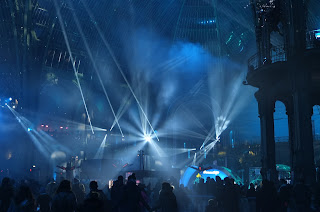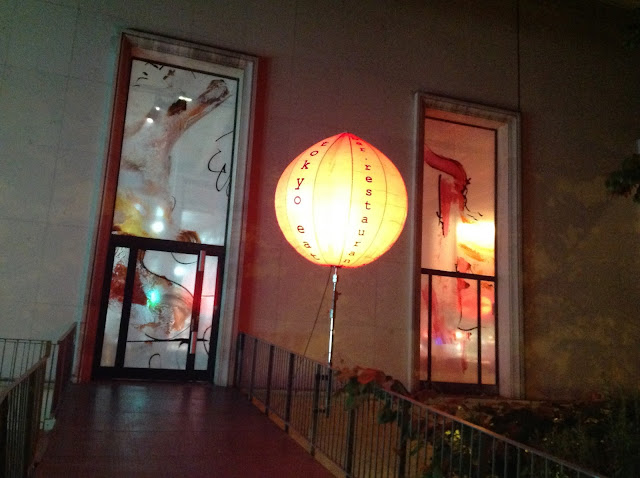Paris is ending the year dans la grisaille,
for which there is no very satisfactory single word in English. The cross on the
top of the spire of the église St Bernard up the road from my sitting room
window hasn’t properly emerged from the murk all day. People have been scurrying along the street like figures in
a Lowry painting, their minds perhaps on the final purchases they need for
their party, the jar of foie gras, the plateau de fruits de mer, another bottle
of prosecco. When I went past Monoprix there was a queue yards long waiting at
the fishmonger’s stall outside. Prawns (flown in from India) had been reduced
from 16 to 12.50 euros a kilo. There were couteaux, bulots, fines de claires,
coquilles St Jacques, homards, langoustines and I don’t know what else.
Multiply that stall by all the others across Paris alone and you begin to
appreciate how thoroughly the seas and the fish farms have been plundered for le
saint Sylvestre.
Picture next, less than a quarter of a mile
from that plenitude, a small square, a couple of benches, a single scraggy tree
and a heap of coloured bedding, sleeping bags, blankets, backpacks. This is
where twenty, maybe more, young men will have huddled together through the
night to keep the worst of the cold out of their bones. They are some of the
young men and boys who line up each morning, blowing on the tips of their
fingers, hugging cold hands under armpits while they wait for their cups of tea
or coffee and their chunk of baguette and chocolate spread.
I've joined an association, les Quartiers
Solidaires, a group of mostly forty-somethings with children at the local
schools, who take it in turns to provide a makeshift breakfast service to the
refugees and other homeless people who sleep on our pavements. I’m still
learning the routine because I haven’t been doing it for long. I don’t yet even
recognize most of those who come. So far I’ve only seen two women and two young
girls, one of them with a very small baby. There are barriers of age, sex and most
of all language between us. The group changes constantly as well. People get
lifted by the police or find another, safer place to pass the night or just
move on.
You could say it’s insulting to offer
hungry men day-old bread and weak tea; it’s shaming or scandalous that the city
doesn’t do more, but in the absence of something better this is definitely
better than nothing. The smiles are real on both sides of the table and there
is warmth in more than the plastic cups of hot liquid.
There are simple practical steps to follow
to do the breakfast. You make sure the chocolate spread is kept somewhere warm
overnight so you can spread it more easily once you’re out on the cold street.
You boil lots of pans of water, fill the thermoses and the urn, call in at the
baker’s along the street to collect yesterday’s unsold baguettes and
viennoiseries, load everything onto two trolleys and trundle these round the
corner to set up the tables for the makeshift buvette on the place. The queue
forms instantly and for the next hour or two you’re busy pouring tea and
coffee, cutting bread and making sandwiches. In the occasional lulls you see
acts of kindness by passers-by as well as occasional outbursts of hostility.
Kindness is a woman handing out a bag full of woollen gloves, another a thick
scarf, another a two big packs of paper hankies. Hostility is a middle-aged man
screaming down the street, ‘Madame, vous avez créé un ghetto! On devrait les
chasser tous! C’est de la merde.’
Down at the Champs Elysées there will have
been other long queues outside le Grand Palais but it shut at 6 o’clock this
evening and won’t open again until tomorrow when it will stay open right
through till 2 am. It’s not the Mexican art exhibition that’s drawing the
crowds but ‘the world’s biggest indoor ice rink’. When we went a few days ago it was still light but by six o’clock
the daylight had fled, the lasers came on in the glass roof and the whole place
became a magical whirling, spinning universe of light and sound.
There are so many wonderful exhibitions to
see at present it’s hard to choose which to mention but two not to miss are the
Icons of Modern Art, the Shchukin Collection at the Fondation Louis Vuitton on
until 20 February. Magritte, la
Trahison des Images is at the Pompidou and ends on 23 January.
Here’s wishing you many wonderful new
experiences in 2017. One of my new year’s resolutions is to turn down the sound
- pay less heed to the chatter and the prophets of doom on both sides of the
Atlantic.













































